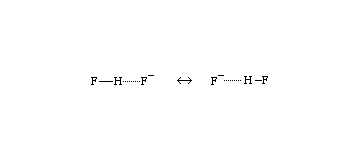 | ||
Bifluoride is an inorganic anion with the chemical formula HF (also written [HF2]−). It contributes no color to bifluoride salts. Salts of bifluoride are used to etch glass.
Contents
Acid-base properties and production
Bifluoride undergoes the typical chemical reactions of a weak acid. Upon treatment with a standard acid, it converts to hydrofluoric acid and a metal salt. Oxidation of bifluoride gives fluorine. When heated, bifluoride salts decompose to produce fluoride salts and hydrogen fluoride:
[HF2]−Bifluoride protonates to give hydrogen fluoride:
HF−2 + H+
Because of this capture of a proton (H+), bifluoride has basic character. Its conjugate acid is the reactive intermediate, μ-fluoro-fluorodihydrogen (H2F2), which subsequently dissociates to become hydrogen fluoride. In solution, most bifluoride ions are dissociated.
HF−2 + H
2O
Bifluoride salts arise by treatment of hydrogen fluoride with base:
HF + F− → [HF2]−Structure
This centrosymmetric triatomic anion features a symmetric hydrogen bond, the strongest known hydrogen bond, with an F−H length of 114 pm and a bond strength of >155 kJ mol−1. A molecular orbital diagram reveals the atoms to be held together by a 3-center 4-electron bond. It is isoelectronic with the fluoroheliate anion, FHeO−, whose existence is suspected but not confirmed. "Hydrogen(difluoride)" is written as one word because it is a unified (covalent) anion; "hydrogen difluoride" would instead imply the electrically neutral compound HF2 (CAS number 12528-21-1).
Salts
Some HF2− salts are common, examples include potassium bifluoride (KHF2, also called potassium hydrogen fluoride) and ammonium bifluoride ([NH4][HF2]). Many salts claimed to be anhydrous sources of simple fluoride (F−) ions, for example, tetra-n-butylammonium fluoride, can decompose to yield bifluoride instead.
Autodissociation of pure HF
The bifluoride ion also contributes to the unusually high auto-protolysis constant of liquid anhydrous hydrogen fluoride, which autodissociates in a manner similar to the self-ionization of water. This equilibrium can be denoted as
HFHowever, both the H+ and F− ions are solvated by HF, so a better descriptive equation is
3HF